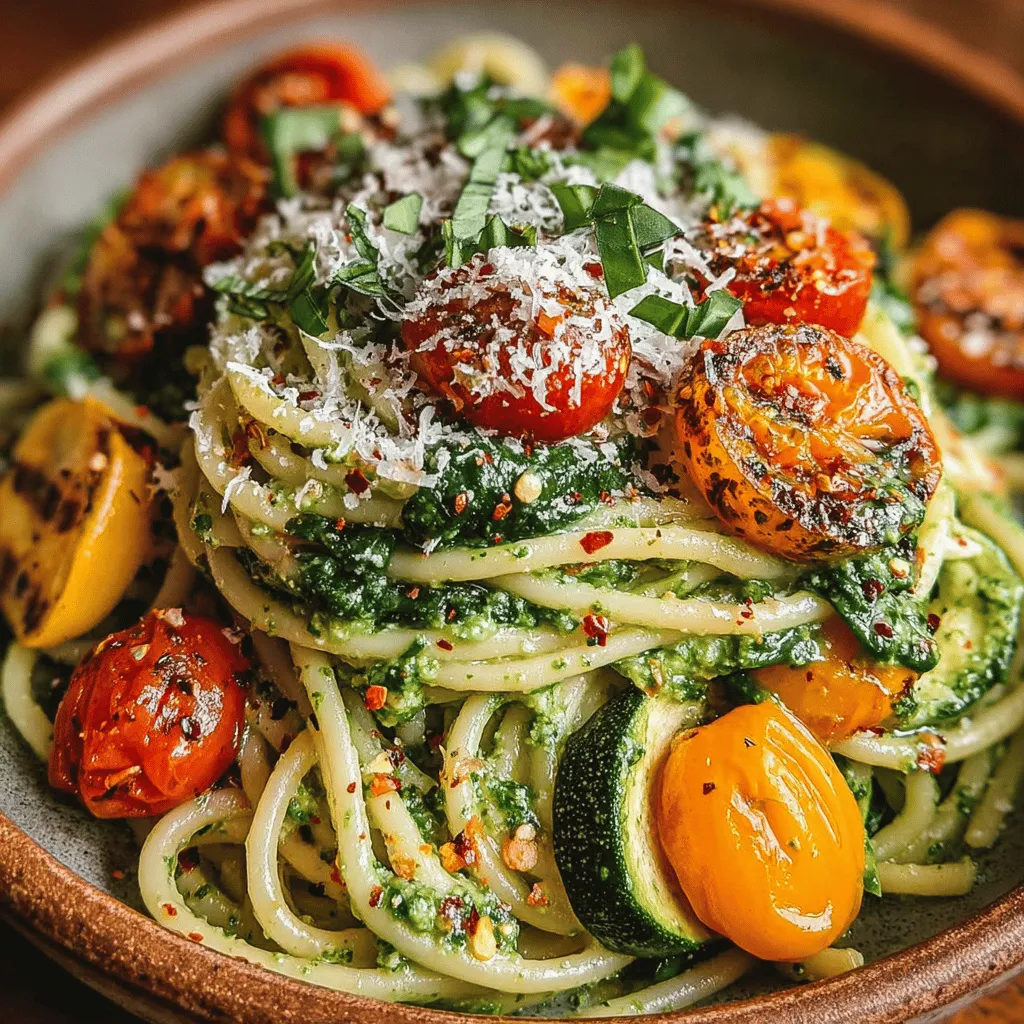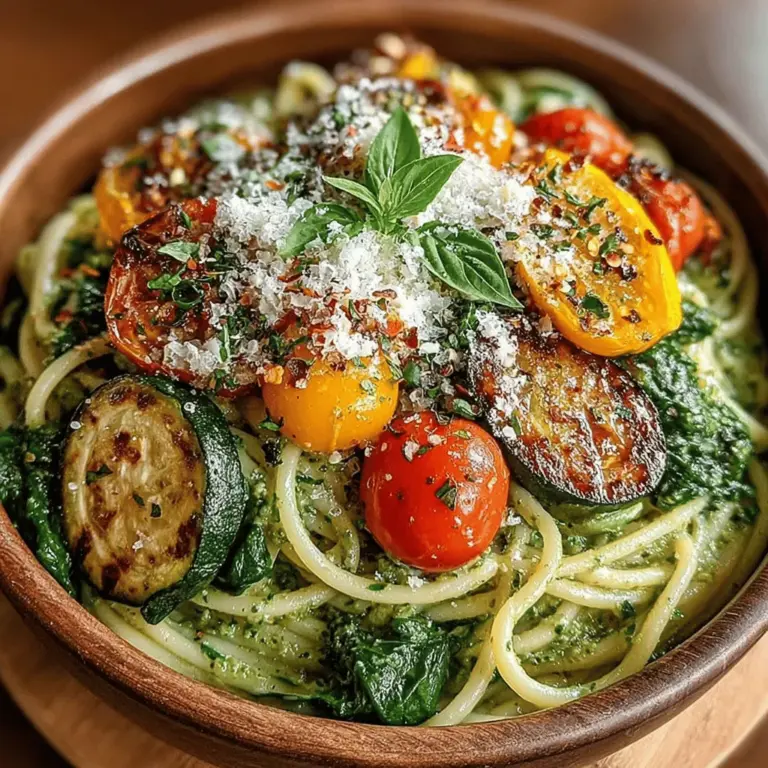Avocado Pesto Veggie Pasta Recipe
Introduction
Avocado Pesto Veggie Pasta is a delightful and nutritious dish that perfectly combines the creamy texture of avocados with the aromatic flavors of fresh basil and garlic, all enveloped in a wholesome pasta base. This dish is not only visually appealing, with its vibrant green colors, but it also promises a burst of flavor in every bite. As more people seek healthier alternatives in their diets, this recipe stands out as an excellent choice for those looking to enjoy a satisfying meal without compromising on taste or nutrition.
The appeal of Avocado Pesto Veggie Pasta lies in its versatility and health benefits. Made with whole wheat pasta, this dish caters to various dietary preferences, including vegan options. Whole wheat pasta is a fantastic alternative to traditional pasta, as it retains the bran and germ of the wheat grain, providing additional fiber, vitamins, and minerals. Coupled with the freshness of the ingredients—like ripe avocados and vibrant basil—this recipe becomes a powerhouse of nutrition and flavor.
Whether you are a health-conscious individual, a busy parent looking for quick meal solutions, or simply a pasta lover seeking new flavors, this Avocado Pesto Veggie Pasta is sure to impress. Let’s dive deeper into the advantages of using whole wheat pasta and the star ingredient of this dish: the avocado.
The Benefits of Choosing Whole Wheat Pasta
When it comes to pasta options, whole wheat pasta stands out for its myriad nutritional advantages. Unlike traditional white pasta, which is made from refined flour, whole wheat pasta is crafted from whole grains, meaning it retains much of its natural fiber and nutrients. This makes it not only a healthier choice but also a more satisfying one.
One of the primary benefits of whole wheat pasta is its high fiber content. Fiber plays a crucial role in maintaining digestive health, helping to regulate blood sugar levels, and promoting a feeling of fullness, which can aid in weight management. Incorporating whole wheat pasta into your meals can contribute to a more balanced diet, providing essential nutrients that are often lost in refined grains.
Moreover, whole wheat pasta is rich in B vitamins, iron, magnesium, and antioxidants, making it a great addition to any meal. These nutrients are vital for energy production, immune function, and overall well-being. By choosing whole wheat pasta for your Avocado Pesto Veggie Pasta, you are not only enhancing the nutritional profile of your dish but also supporting a healthier lifestyle.
The Star Ingredient: Avocado
No discussion of Avocado Pesto Veggie Pasta would be complete without highlighting the star ingredient: the avocado. This creamy fruit is not only delicious but also packed with a wealth of nutritional benefits that make it a favorite among health enthusiasts.
Avocados are renowned for their high content of healthy monounsaturated fats, particularly oleic acid. These fats are beneficial for heart health, as they can help to lower bad cholesterol levels and reduce the risk of heart disease. Additionally, avocados are an excellent source of vitamins and minerals, including vitamin K, vitamin E, vitamin C, and several B vitamins. They also contain potassium, which is essential for maintaining healthy blood pressure levels.
Another significant advantage of avocados is their versatility. While they are often associated with savory dishes, avocados can also be used in sweet recipes, making them a staple in both breakfast and dessert options. Their creamy texture allows them to blend seamlessly into sauces, smoothies, and dips, making them an ideal base for the avocado pesto in this recipe.
Creating the Perfect Avocado Pesto
Pesto is a classic Italian sauce traditionally made with basil, garlic, pine nuts, olive oil, and Parmesan cheese. It’s known for its vibrant flavor and aromatic profile, making it a popular choice for pasta dishes. However, the traditional recipe can be enhanced and made even more nutritious with a unique twist: incorporating avocados.
To create the perfect avocado pesto, start by selecting ripe avocados, as their creamy consistency will provide the ideal texture for the sauce. Combine the avocados with fresh basil, garlic cloves, nuts (such as pine nuts, walnuts, or almonds), and a splash of lemon juice for brightness. A drizzle of high-quality olive oil will help to bring all the ingredients together and add richness to the sauce.
When blending the ingredients, it’s essential to achieve a smooth and creamy consistency. You may need to adjust the amount of olive oil or add a little water to reach your desired texture. Taste the pesto and balance the flavors by adding salt, pepper, or extra lemon juice as needed. This flexibility allows you to customize the pesto to your liking, ensuring that it complements your pasta perfectly.
Essential Ingredients for Avocado Pesto Veggie Pasta
To prepare Avocado Pesto Veggie Pasta, you’ll need a few key ingredients that work together to create a harmonious dish. Here’s a breakdown of the main components:
1. Avocados: The base of the pesto, providing creaminess and healthy fats.
2. Fresh Basil: Essential for that classic pesto flavor, basil adds a fragrant aroma and bright freshness to the dish.
3. Garlic: Adds depth and flavor, enhancing the overall taste of the pesto.
4. Nuts: Pine nuts are traditional, but walnuts or almonds can also provide a delightful crunch and nuttiness.
5. Cheese: For a non-vegan option, Parmesan cheese adds a savory richness to the pesto. For those following a vegan diet, nutritional yeast can be used as a cheese substitute, offering a similar umami flavor.
6. Whole Wheat Pasta: The foundation of the dish, providing fiber and essential nutrients.
Additionally, using fresh ingredients is crucial in maximizing both flavor and nutrition. Fresh basil, ripe avocados, and high-quality olive oil can elevate the dish, making it not just a meal but an experience to savor. By selecting seasonal and organic produce whenever possible, you enhance not only the taste but also the health benefits of your Avocado Pesto Veggie Pasta.
In the next part of this article, we will delve into the step-by-step instructions for preparing this delicious dish, ensuring that you can recreate this culinary delight in your own kitchen. Stay tuned for a detailed guide that will take you from preparation to plate, making your cooking experience enjoyable and rewarding.

Substitutions for Dietary Restrictions
When preparing your Avocado Pesto Veggie Pasta, it’s essential to consider dietary restrictions or preferences. There are numerous easy substitutions that can help you cater to different needs while still achieving a delicious meal.
– Nuts for Seeds: If you or someone you’re serving has a nut allergy, you can easily swap out nuts for seeds in your pesto. Pumpkin seeds or sunflower seeds are excellent alternatives that still provide healthy fats and a satisfying crunch.
– Nutritional Yeast for Cheese: For those following a vegan diet or looking to reduce dairy intake, nutritional yeast is a fantastic substitute for cheese. It adds a cheesy flavor without the dairy, making your dish both creamy and flavorful.
– Gluten-Free Pasta: If you require a gluten-free option, substitute regular pasta with gluten-free varieties such as brown rice or chickpea pasta. These alternatives are more nutritious and will still hold the sauce beautifully.
These substitutions ensure that everyone can enjoy this colorful and nutritious dish without compromising taste or texture.
Cooking the Pasta: Tips for Optimal Texture
Cooking pasta correctly is paramount to achieving the perfect Avocado Pesto Veggie Pasta. The goal is to create pasta that is al dente, which means “to the tooth” in Italian. This texture ensures the pasta has a slight firmness when bitten, providing the ideal base for the creamy pesto.
Importance of Cooking Pasta Al Dente
Cooking pasta al dente not only enhances its texture but also helps it hold up better against the sauce. Overcooked pasta can become mushy and lose its ability to absorb flavors, resulting in a less satisfying dish. To achieve the perfect al dente pasta, follow the package instructions but start checking for doneness a couple of minutes before the recommended time.
How to Properly Reserve Pasta Water
One of the secrets to a perfectly creamy sauce is the reserved pasta water. As the pasta cooks, it releases starches into the water, which can help emulsify the sauce and make it adhere better to the pasta.
To reserve pasta water:
1. Before draining the pasta, use a measuring cup to scoop out about a cup of the cooking water.
2. Set it aside while you drain the pasta.
3. This starchy water can be added to your sauce later to help achieve your desired consistency.
Sautéing the Vegetables: Adding Color and Nutrition
Incorporating fresh vegetables into your Avocado Pesto Veggie Pasta not only enhances the dish’s nutritional profile but also adds vibrant colors and textures that make the meal visually appealing.
Benefits of Incorporating Fresh Vegetables
Fresh vegetables are packed with vitamins, minerals, and fiber, making your dish not just delicious but nutritious too. For instance, bell peppers are rich in vitamin C, while zucchini is a great source of vitamins A and B6. By adding a variety of vegetables, you increase the meal’s health benefits and create a more satisfying dining experience.
Recommended Veggies and Their Health Benefits
Here are a few recommended vegetables you can incorporate into your pasta:
– Cherry Tomatoes: Add a burst of flavor and are rich in antioxidants.
– Spinach: Nutrient-dense and adds a lovely green color, packed with iron and vitamin K.
– Bell Peppers: Their sweetness and crunch contrast beautifully with the creamy pesto.
– Zucchini: Provides a light texture and is a low-calorie option.
Techniques for Sautéing to Maintain Flavor and Nutrients
To sauté vegetables effectively while preserving their flavor and nutrients, consider the following tips:
1. Use a High-Quality Olive Oil: A good-quality olive oil not only enhances flavor but also provides healthy fats.
2. Avoid Overcrowding the Pan: Cook in batches if necessary to ensure even cooking and prevent steaming.
3. Cook on Medium-High Heat: This allows vegetables to caramelize slightly, enhancing their natural sweetness.
4. Season as You Go: A pinch of salt during cooking helps draw out moisture and flavor.
Combining Flavors: The Final Steps
Once your pasta is cooked and your vegetables are sautéed, it’s time to bring everything together. This crucial step ensures that every bite is packed with the delicious flavors of your Avocado Pesto Veggie Pasta.
Importance of Gently Combining Pasta, Vegetables, and Pesto
To create a harmonious dish, gently combine the pasta, sautéed vegetables, and avocado pesto. This can be done in a large mixing bowl or directly in the pot used for cooking the pasta.
Tips for Achieving the Right Creaminess in the Dish
1. Add Reserved Pasta Water Gradually: As you mix, slowly add the reserved pasta water until you reach your desired creaminess.
2. Toss, Don’t Stir: Gently toss the ingredients together to avoid breaking the pasta and to ensure even coating with the pesto.
3. Taste and Adjust: Before serving, taste the dish and adjust seasoning. You may want to add more salt, pepper, or even a pinch of red pepper flakes for heat.
How to Adjust Flavors for Personal Preference
Every palate is different. Be sure to:
– Experiment with Seasoning: If you prefer a tangier flavor, consider adding a squeeze of fresh lemon juice or a dash of balsamic vinegar.
– Incorporate Fresh Herbs: Fresh basil or parsley can elevate the dish and add extra freshness.
– Add Protein: For those looking to add protein, grilled chicken or chickpeas can be a great addition.
Serving Suggestions for Avocado Pesto Veggie Pasta
Plating your Avocado Pesto Veggie Pasta beautifully can enhance the dining experience. Here are some ideas to make your dish not only delicious but visually appealing.
Ideas for Plating and Garnishing for Visual Appeal
1. Use a Large Serving Bowl: Presenting the pasta in a large bowl allows for family-style serving and encourages sharing.
2. Garnish with Fresh Herbs: Sprinkle some fresh basil or parsley on top for a pop of color.
3. Add a Drizzle of Olive Oil: A light drizzle of high-quality olive oil just before serving can enhance flavor and provide a glossy finish.
Suggestions for Side Dishes or Pairings to Complete the Meal
To complement your Avocado Pesto Veggie Pasta, consider serving:
– Garlic Bread: A classic pairing that adds a crunchy texture.
– Mixed Green Salad: A light and refreshing salad can balance the richness of the pasta.
– Grilled Vegetables: For added flavor, grill seasonal vegetables and serve them on the side.
Options for Storing Leftovers and Reheating Tips
If you have leftovers, store them in an airtight container in the refrigerator for up to three days. Here are some reheating tips to maintain the dish’s quality:
– Microwave: Heat in short intervals, stirring in between to ensure even heating.
– Stovetop: Reheat in a pan over low heat, adding a splash of reserved pasta water to prevent drying out.
Conclusion
Your Avocado Pesto Veggie Pasta is not just a simple dish; it’s a celebration of fresh ingredients, vibrant flavors, and health benefits. Packed with vitamins, healthy fats, and fiber, this meal is a perfect choice for anyone looking to enjoy a nutritious, delicious dinner.
Embrace the joy of cooking and experimenting with fresh ingredients. Each time you make this dish, you can customize it to your liking, making it distinctly your own. The satisfaction that comes from creating a vibrant, healthy meal at home is unparalleled, and your Avocado Pesto Veggie Pasta is sure to become a favorite in your culinary repertoire. Enjoy every bite and share the experience with loved ones!


